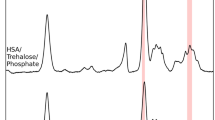Abstract
Purpose. The mobility of protein in powders at different hydration levels was studied in relation to aggregation and activity.
Methods. Magic angle spinning 13C, 15N, 1H, 2H, and 17O NMR techniques were used to determine changes in the mobility of surface residues in proteins as a function of hydration and related to changes in activity. NMR relaxation measurements of high frequency (ω0, T1) and low frequency (ω1, T1p) motions have been carried out on lyophilized DNase, insulin and lysozyme stored at different relative humidities. Moisture-induced aggregation and enzymatic activity of the lyophilized proteins was determined by high performance size exclusion chromatography and bioassays.
Results. There was little change in T1p observed with increasing humidity. The results show, however, that there is a decrease in T1, for DNase, insulin and lysozyme at relative humidities ranging from 0−98%, and we propose that the reduction in T1, is related to the aggregation susceptibility of proteins during storage at different humidities. The water mobility was determined directly using 17O NMR experiments. We found that as the amount of weakly-bound water increases, the protein surface mobility decreases and is coupled with increased aggregation. Aggregation measurements at different humidities were correlated with bioassays for lysozyme and found to be consistent with the hydration data.
Conclusions. Mobility of protein molecules was determined by solid-state NMR over a wide range of % RH and it was found that water content leads to a change in mobility of protein molecules. The aggregation and activity of proteins were strongly correlated to change in molecular mobility.
Similar content being viewed by others
REFERENCES
R. F. Service. Drug delivery takes a deep breath. Science 277:1199–1200 (1997).
T. J. Ahern and M. C. Manning. Stability of Protein Pharmaceuticals Part A Chemical and Physical Pathways of Protein Degradation, Plenum Press, NY, 1992.
R. B. Gregory, M. Gangoda, R. K. Gilpin, and W. Su. The influence of hydration on the conformation of lysozyme studied by solid state 13C-NMR spectroscopy. Biopolymers 33:513–519 (1993).
H. R. Costantino, R. Langer, and A. M. Klibanov. Moisture-induced aggregation of lyophilized insulin. Pharm. Res. 11:21–29 (1994).
S. Yoshioka, Y. Aso, and S. Kojima. Determination of molecular mobility of lyophilized Bovine Serum Albumin and γ-Globulin by solid-state H NMR and relation to aggregation-susceptibility. Pharm. Res. 13:926–930 (1996).
R. K. Harris. State of the art for solids. Chemistry in Britain, pp. 601–604 (1993).
C. R. Kahn and L. C. Harrison, Receptor Biochemistry and Methodology, volume 12 A. Methods for study of structure and functions, Liss, New York, 1988.
P. Jolles. Lysozymes: Model Enzymes in Biochemistry and Biology, Birkhauser, Boston, 1996.
H.-K. Chan, A. Clark, I. Gonda, M. Mumenthaler and C. Hsu. Spray dried powders and powder blends of recombinant human deoxyribonuclease (rhDNase) for aerosol delivery. Pharm. Res. 14:431–437 (1997).
D. R. Lide (ed.). Handbook of Chemistry and Physics, CRC Press, Boca Raton, 1996; E. W. Washburn (ed.). International Critical Tables of Numerical Data, Physics, Chemistry and Technology, vol. 1. McGraw-Hill, New York, 1926.
A. E. El-Nimr. A standard method for determination of lysozyme activity via controlling the kinetics of substrate-enzyme interactions. Drug Dev. Ind. Pharm. 11:653–662 (1985).
L. D. Field and S. Sternhell. Analytical NMR, Chichester Press, New York, 1989.
E. D. Becker. High Resolution NMR, Theory and Chemical Application, Academic Press, New York, 1980.
D.J. Wink. Spin-lattice relaxation times in 1H NMR spectroscopy. J. Chemical Education, 66:810–813. (1989).
The Merck Index, 10th edition, An Encyclopedia of Chemicals, Drugs and Biologicals, Merck & Co. Inc., Rahway NJ, USA (1983).
G. Valensin and N. Niccolai. Cross relaxation effects on the longitudinal relaxation rate of water in protein solutions. Chem. Phys. Lett. 79:47–50 (1981).
D. Shaw. Fourier Transform NMR Spectroscopy, Elsevier Scientific Pub. Co., New York, 1976.
J. W. Emsley, J. Feeney, and L. H. Sutcliffe. High Resolution Nuclear Magnetic Resonance Spectroscopy, Volume 1, Pergamon Press, Oxford, 1965.
J. C. Hindman, A. Svirmickas, and M. Wood. The spin-lattice relaxation of oxygen-17 in water. J. Phys. Chem. 74:12, 66 (1970).
F. W. Cope. Nuclear magnetic resonance evidence using D2O for structured water in muscle and brain. Biophys. J. 9:303–319 (1969).
F. Volke, S. Eisenblaetter, J. Galle, and G. Klose. Dynamic properties of water at phosphatidylcholine lipid-bilayer surfaces as seen by deuterium nuclear magnetic resonances approach, Methods in Enzymology 220:143–157 (1993).
W. R. Liu, R. Langer, and A. M. Klibanov. Moisture-induced aggregation of lyophilized proteins in the solid state. Biotech. and Bioengineer. 37:177–184 (1991).
M. Katakam and A. K. Banga. Aggregation of insulin and its prevention by carbohydrate excipients. PDA J. Pharm. Sci. and Tech. 49:160–165 (1995).
G. M. Jordan, S. Yoshioka, and T. Terao. The aggregation of bovine serum albumin in solution and in solid state. J. Pharm. Pharmacol. 46:182–185 (1994).
S. J. Prestrelski, N. Tedeschi, T. Arakawa, and J. F. Carpenter. Dehydration-induced comformational transitions in proteins and their inhibition by stabilizers, Biophys. J. 65(2):661–671 (1993).
K. Griebenow and A. M. Kibanov. Lyophilization-induced reversible channels in the secondary structure of proteins, Proc. Nat. Acad. Sci. USA 92:10969–10976 (1995).
Author information
Authors and Affiliations
Rights and permissions
About this article
Cite this article
Separovic, F., Lam, Y.H., Ke, X. et al. A Solid-State NMR Study of Protein Hydration and Stability. Pharm Res 15, 1816–1821 (1998). https://doi.org/10.1023/A:1011993620177
Issue Date:
DOI: https://doi.org/10.1023/A:1011993620177




